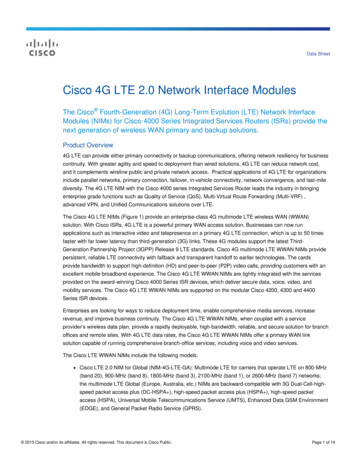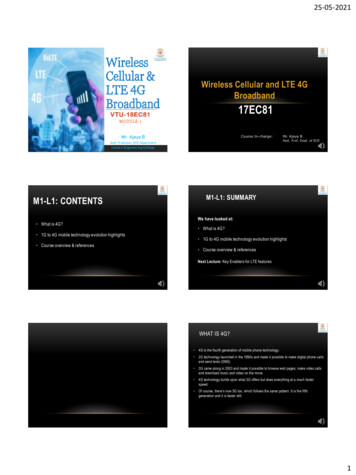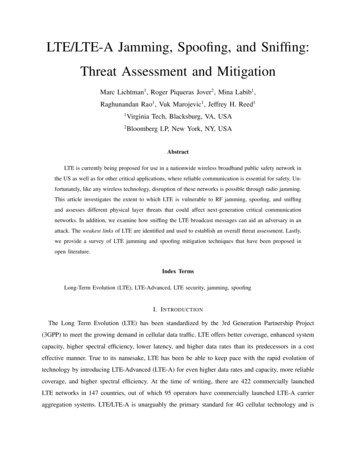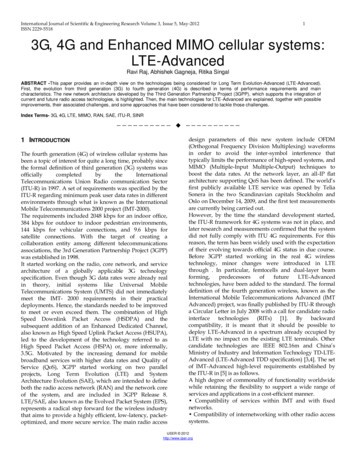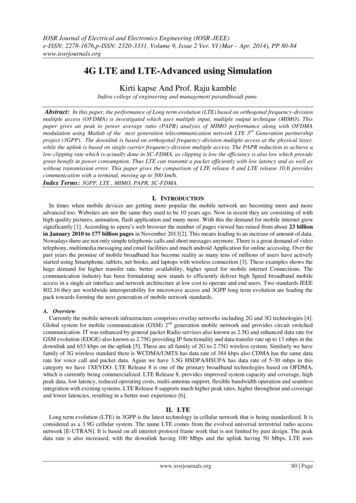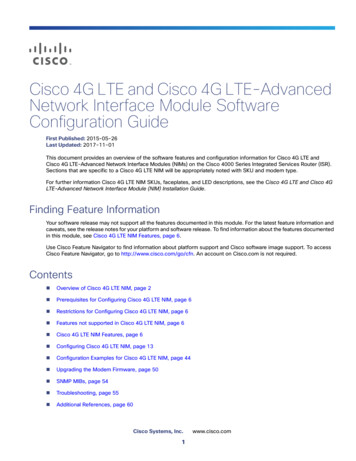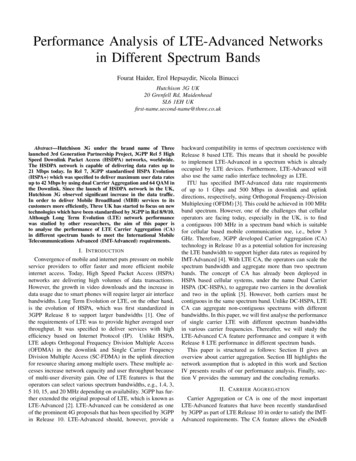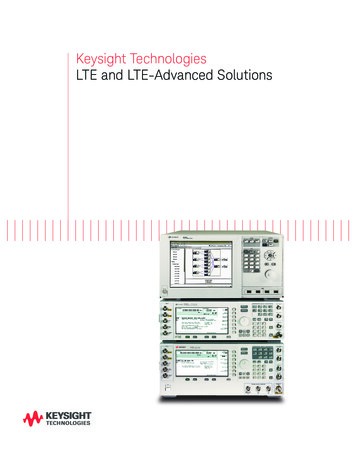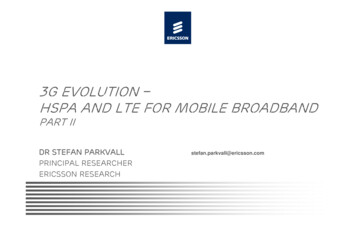
Transcription
3G Evolution –HSPA and LTE for Mobile BroadbandPart IIDr Stefan ParkvallPrincipal ResearcherEricsson Researchstefan.parkvall@ericsson.com
OutlineSeries of three seminarsI. Basic principles– Channel and traffic behavior– Link adapation, scheduling, hybrid-ARQ– Evolving 3G, inclusion of basic principles in WCDMAII. LTE– First step into 4G– Path towards IMT-AdvancedIII. Standardization– How are HSPA and LTE created?– 3GPP, ITU, . Ericsson AB 2009 Ericsson Internal X (X) Date
Recap from First session› Radio channel quality is time varying› Traffic pattern is time varying› Adapt to and exploit – variations in the radio channel quality– variations in the traffic pattern instead of combating them! Ericsson AB 2009 Ericsson Internal X (X) Date
Recap from First session› Shared channel transmission› Channel-dependent scheduling› Rate control› Hybrid-ARQ with soft combining Ericsson AB 2009 Ericsson Internal X (X) Date
Recap from First sessionShared channel transmissionChannel-dependent schedulingHSPA (“Turbo-3G”)› Packet-data add-on to WCDMA› First version 2002, still evolving› Using principles from first sessionHybrid ARQ5 MHz 5 MHzfMulti-carrier transmission10 MHz Ericsson AB 2009 Ericsson Internal X (X) DateMulti-antenna supportRate control
LTELong-Term EvolutionWCDMAHSDPAHSPAHSPA LTE
HSPA and LTE Mobile Broadband› HSPA – High-Speed Packet Access (”Turbo-3G”)– Gradually improved performance at a low additional cost› LTE – Long-Term Evolution (”4G”)– Significantly higher performance in a wide range of spectrum allocations› Downlinkup to 300 Mbit/s› Uplinkup to 75 Mbit/s› Reduced latency10 ms RTT– Packet-switched services onlyWCDMAHSDPA2002HSPA evolutionHSPA20042005200620072008LTEStefan ParkvallRequirements Ericsson AB 2009 Ericsson Internal X (X) DateStudiesSpec’s
LTE – 4G Mobile BroadbandFrom early studies Testbed 2007, 20 MHz, 2x2MIMO1541239774543723LTE Testbed2007 via trials 12 700 m to index.htm Ericsson AB 2009 Ericsson Internal X (X) ses/2009/12/1360881
Spectrum Flexibility› Operation in differently-sized spectrum allocations– Core specifications support any bandwidth from 1.4 to 20 MHz– Radio requirements defined for a limited set of spectrum allocations1.4 MHz3 MHz5 MHzRB ( 1.4 MHz)10 6MHz15 MHz20 MHz100 RB ( 20 MHz)› Support for paired and unpaired spectrum allocationswith a single radio-access technology Dtime Ericsson AB 2009 Ericsson Internal X (X) DateHalf-duplex FDD(terminal-side only)cyenuqfretimeTDDtime
Transmission SchemeDownlink – OFDMUplink – DFTS-OFDM› Parallel transmission on large numberof narrowband subcarriers› DFT-precoded OFDMDFT precoderIFFTCyclic-prefixinsertion› Benefits:– Avoid own-cell interference– Robust to time dispersion› Main drawback– Power-amplifier efficiencyDFTOFDM modulatorIFFTCyclic-prefixinsertion› Tx signal has single-carrier properties@ Improved power-amplifier efficiency– Improved battery life– Reduced PA cost– Critical for uplink› Equalizer needed @ Rx Complexity– Not critical for uplink Ericsson AB 2009 Ericsson Internal X (X) Date
Time Dispersion and OFDM› Time dispersion inter-symbol interference– Requires receiver-side processing (equalization)› OFDM – transmission uses multiple ‘narrowband’ subcarriers– Including of cyclic prefix completely mitigates time dispersion (up to CP) atthe cost of additional overhead simple receiverSingle carrier(delayed copy) Ericsson AB 2009 Ericsson Internal X (X) Daten 1n 1nn-1nn-1Path 2n-2Path 1n-2Detect symbol nOFDMDetect symbol n
Downlink – OFDMΔf0Block ofM symbolsSize-NIFFTM subcarriers0Tu 1/ΔfCPinsertionTCPTCP-ETuTu› Parallel transmission using a largenumber of narrowband “sub-carriers”› “Multi-carrier” transmission– Typically implemented with FFT› Insertion of cyclic prefix prior totransmission– Improved robustness in time-dispersivechannels – requires CP delay spread– Spectral efficiency loss Ericsson AB 2009 Ericsson Internal X (X) DateConfiguration, ΔfNormalCP lengthSymbolsper slot15 kHz 4.7 μs715 kHz 16.7 μs67.5 kHz 33.3 μs3Extended
Uplink – DFT-spread OFDM (‘SC-FDMA’)› Single-carrier uplink transmission efficient power-amplifier operation improved coverage– OFDM requires larger back-off than single-carrier– DFT-spread OFDM – OFDM with DFT precoder to reduce PAR› Uplink numerology aligned with downlink numerologyTerminal ADFT(M1)IFFT0CPinsertionM1 M2Terminal BDFT 0(M2) Ericsson AB 2009 Ericsson Internal X (X) DateIFFTCPinsertion
Time-domain Structure› FDD– Uplink and downlink separated in frequency domainOne radio frame, Tframe 10 msOne subframe, Tsubframe 1 msfULfDLULDLSubframe #0#1#2#3#4#5#6#7#8#9› TDD– Uplink and downlink separated in time domain ”special subframe”– Same numerology etc as FDD economy of scale(special subframe)(special subframe)ULfDL/ULDLDwPTSGPUpPTS Ericsson AB 2009 Ericsson Internal X (X) Date
Physical ResourcesOne frame (10 ms)One resource elementOne subframe (1 ms)12 sub-carriersOne slot (0.5 ms)TCP Ericsson AB 2009 Ericsson Internal X (X) DateTu
Protocol ArchitectureUser #iUser #jSAE bearersPDCPPDCPHeader Compr.Ciphering› Packet DataConvergence Protocol› PDCP – Packet DataConvergenceProtocolHeader Compr.– Header compression to– Header compression to reduce overheadreduce overhead– Ciphering for securityDeciphering– Ciphering for securityRadio BearersRLCPayload selectionSegmentation, ARQPriority handling,payload selectionMACMAC schedulerMAC dPHYData modulationModulationAntenna andresourceassignment– Multiplexing of radio bearersHybrid-ARQ retransmissionsHybridARQARQHybrid– Multiplexing ofradiobearers–Transport –ChannelHybrid-ARQ retransmissionsPHYCoding RMCodingModulationscheme› RLC – RadioRLC Link Control› Radio Link Control– Segmentation/concatenation– Segmentation/concatenationReassembly, ARQ– RLC retransmissions– In-sequence deliveryLogical Channels– RLC xing› Medium Access Control› MAC – MediumMACAccessControlRedundancyversionMACAntenna and resrouceAntenna and resourcemappingmapping Ericsson AB 2009 Ericsson Internal X (X) DateCoding RM› PHY – Physical DecodingLayer› Physical LayerData modulation– Coding, Modulation– Coding, Modulation– Multi-antenna processing– Multi-antenna processing – Resource mapping– Resource mappingDemodulationAntenna and resrouceAntenna and resourcemappingdemapping
Data Flow in LTESAE bearer 1SAE bearer hdrPayloadhdrPayloadPDCPPDCPheaderRLCPDCPheaderRLC SDUMACheaderPHY Ericsson AB 2009 Ericsson Internal X (X) DatePDCPheaderRLC SDURLCheaderMACSAE bearer 2RLC SDURLCheaderRLCheaderMACheaderMAC SDUTransport BlockCRCMAC SDUTransport BlockCRC
Architecture› Core network evolved in parallel to LTE– EPC – Evolved Packet Core› Flat architecture, single RAN node, the eNodeB– Compare HSPA, which has an RNCInternetPSTNCore NetworkInternetCore NetworkRNCRNCto other Node Bsto other Node BsDedicated channelseNodeBNodeBUELTE Ericsson AB 2009 Ericsson Internal X (X) DateUEHSPA
Channel-dependent Scheduling› LTE – channel-dependent scheduling in time and frequency domain– HSPA – adaptation in time-domain onlyTime-frequency fading,data1 user #1data2data3data4Time-frequencyfading, user #2User #1 scheduledUser #2 scheduled1msTime Ericsson AB 2009 Ericsson Internal X (X) DatecyFrequen180 kHz
Uplink Scheduling› Base station mandates data rate of terminal– Unlike HSPA where terminal selects data rate [limited by scheduler]– Motivated by orthgonal LTE uplink vs non-orthgonal HSPA uplinkeNodeBeNodeBRLC bufferSchedulerRLC bufferSchedulerMAC multiplexingUplink channel qualityUETFselectionChannelstatusBuffer StatusModulation, codingUEDownlink channelqualityPriority handlingModulation, codingMAC multiplexingRLC bufferDownlink Ericsson AB 2009 Ericsson Internal X (X) DateUplinkRLC buffer
Hybrid-ARQ with Soft Combining› Parallel stop-and-wait processes– 8 processes 8 ms roundtrip timeTo RLC for in-sequence deliveryBlock 2Hybrid-ARQprotocolBlock 3Block 4Block 5Block 1Process #7Process #2Process transport block 4Process transport block 2Process #0Process transport block 1Process transport block 11Process transport block 5Process transport block 3Process #123 Ericsson AB 2009 Ericsson Internal X (X) Date145Process transport block 11
Interaction with RLC› Why two transmission mechanisms, RLC and hybrid-ARQ?– Retransmission protocols need feedback› Hybrid ARQ [with soft combining]– Fast retransmission, feedback every 1 ms interval– Frequent feedback need low overhead, single bit– Single, uncoded bit errors in feedback ( 10-3)› RLC– Reliable feedback (sent in same manner as data)– Multi-bit feedback less frequent› Hybrid-ARQ and RLC complement each other Ericsson AB 2009 Ericsson Internal X (X) Date
Multi-antenna transmission techniquesDiversity for improvedBeam-forming for improved coveragesystem peformance(less cells to cover a given area)SDMA for improved capacityMulti-layer transmisson (”MIMO”)(more users per cell)for higher data rates in a given bandwidthThe multi-antenna technique to use depends on what to achieve Ericsson AB 2009 Ericsson Internal X (X) Date
Scheduling and Interference Handling› Scheduling strategy strongly influences system behavior– Trade-off between capacity and uniform service provisioning– Can take inter-cell interference into account› Improve cell-edge data rates.at the cost of system throughput› Autonomous handling complemented by exchange of coordinationmessages between base stationsCell BCell A Ericsson AB 2009 Ericsson Internal X (X) Date
LTE – Continuous EvolutionOFDM transmissionMulti-antenna supportICICDual-layer beamformingMulti-antenna t schedulingBandwidth flexibilityHybrid ARQFDD and TDD supportRel-82008Basic LTE functionalityPositioningRelayingMBMSCarrier AggregationRel-92009Enhancements & extensionsRel-102010Further extensionsIMT-Advanced compliant Ericsson AB 2009 Ericsson Internal X (X) Date
MBSFN OperationRel-9› Multicast-Broadcast Single Frequency Network– Synchronized transmission from multiple cells– Seen as multipath propagation by terminal combining gain ‘for free’› MBSFN for content known to have many viewers– News, sport events, On demandPersonalized content Ericsson AB 2009 Ericsson Internal X (X) DateBig eventsKnown in advance to have many users
Carrier AggregationRel-10› Multiple component carriers operating in parallel– Rel-8 – one component carrier– Rel-10 – up to five component carriersRel-8Rel-10› Use cases– Bandwidths beyond 20 MHz higher data rates– Exploitation of fragmented spectrum› Straight-forward baseband – challenging RF implementationIntra-band aggregation,contiguous component carriersFrequency band AFrequency band BIntra-band aggregation,non-contiguous component carriersFrequency band AFrequency band BFrequency band AFrequency band BInter-band aggregation Ericsson AB 2009 Ericsson Internal X (X) Date
RelayingRel-10› Repeater– Possible already in Rel-8, simply amplifies and retransmits received signal› Relaying (added in Rel-10)– Relay small base station connected to RAN using LTE radio resources– Interesting if fiber/microwave is more expensive than using LTE spectrumbackhaullinkaccess linRelay cellDonor cell Ericsson AB 2009 Ericsson Internal X (X) Datek
Non-uniform DeploymentsImproved Support in Rel-10› What?Low power nodes placed throughout a macro-cell layout– Hierarchical Cell Structures – an old idea revisited› Why?High data rates dense infrastructure.but non-uniform user distribution– Macro for coverage, pico for high data rates› How?› “Conventional”–Independent pico cells Ericsson AB 2009 Ericsson Internal X (X) Date›“Relay”–Independent relay cells–Relay connected to macro›“RRU”–Remote “pico antenna”,processing in macro–No new pico cells
Beyond Rel-10 – CoMP› CoMP – Coordinated Multi-point transmission/reception› Tx/Rx from single point at a time› Tx/Rx from multiple points at a time– Scheduling coordination to avoidsevere interference situations– Joint transmission to improve SINRCoordination› Coordinated precoding/beamforming– Requires spatial information aboutchannels to non-serving cells› Coherent or non-coherent transmission– Coherent requires accurate tracking ofrelative phases between pointsCoMP – emerging technology, studied in 3GPP – not part of Rel-10 Ericsson AB 2009 Ericsson Internal X (X) Date
LTE Rel-8 - SummaryFDD and TDD supportIFFTTransmission schemeDL OFDM, UL DFTS-OFDMBandwidth flexibilityFundamental principle:data1data2data3data4adapt to and exploit variations in radio channelquality traffic patternICICHybrid ARQMulti-antenna support Ericsson AB 2009 Ericsson Internal X (X) DateChannel-dependent scheduling
LTE Rel-9 - RefinementsLTE Rel-9NWESMBSFNdata1data2data3data4LTE Rel-8Dual-streamBeamforming Ericsson AB 2009 Ericsson Internal X (X) DatePositioning
LTE Rel-10 – IMT-AdvancedLTE Rel-10Carrier AggregationMIMO extensionsLTE Rel-9Up to 4x4 UL and 8x8 DLNWESLTE Rel-8Enhanced HetNet support Ericsson AB 2009 Ericsson Internal X (X) Datedata1data2data3data4Relaying
For Further information Open the 3GPP specifications.or read The Book!Available in English, Chinese, Korean and Japanese. Ericsson AB 2009 Ericsson Internal X (X) Date
HSPA and LTE Mobile Broadband › HSPA - High-Speed Packet Access ("Turbo-3G") - Gradually improved performance at a low additional cost › LTE - Long-Term Evolution ("4G") - Significantly higher performance in a wide range of spectrum allocations › Downlink up to 300 Mbit/s › Uplink up to 75 Mbit/s › Reduced latency 10 .



